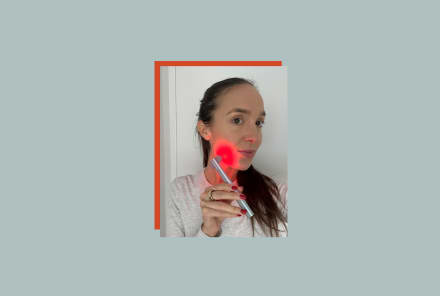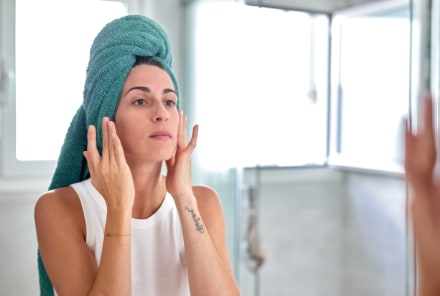Advertisement
Laugh Lines: What They Are, Why We Get Them & 7 Natural Remedies That Work

For something sounding so joyful, laugh lines sure do cause people grief. But remember this type of wrinkle is a totally normal part of the aging process—as are all wrinkles for that matter. Laugh lines are given their name because of their location (around the mouth) and one of the ways you may develop them (uh, laughing). So if you see them creeping in, take it as a sign you've had a good ole time.
Here, get into the details, causes, how to tend to them naturally (it is possible), and easy prevention tips.
What are laugh lines?
As we noted, their name gives a good indication of their placement: "Laugh lines are wrinkles that appear on the face and extend from the outer edge of your nostrils down to the corner of your mouth," says board-certified dermatologist Margarita Lolis, M.D., of Schweiger Dermatology Group in Hackensack, New Jersey.
You may also hear them called "smile lines," "marionette lines," or the more technical "nasolabial folds," says aesthetic registered nurse Neethi Masur, R.N. at SKINNEY MedSpa.
If you're having trouble picturing this, go to the mirror and shoot yourself a big grin. The distinct lines that you see that appear like a stretched-out closed parenthesis? Those are your nasolabial folds.
How do they form?
Skin is a complex, living organ made up of several structural components that (quite literally) touches a lot of different parts of us. When you look at the makeup, there's collagen, elastin, hyaluronic acid, ceramides, lipids, and so forth; from there, it's also affected by the muscle composition and bone underneath. This is all to say, when wrinkles form—it's hardly ever due to a singular reason.
So to start, there is the fact that many components of our skin structure decline with age. "As we age, we lose collagen, fat, and start to resorb bone. These changes lead to volume loss, thin, saggy skin. As a result, our nasolabial folds become more pronounced," says Lolis.
It's also important to note that these lines are exacerbated with movement, the same way crow's feet can come from squinting and the "11's" can come from scrunching your brow.
"Laugh lines are formed by constant use of the orbicularis orbis muscle which allows us the ability to speak," says Masur. "Over time as we age the skin protecting this muscle becomes stretched creating laxity increasing the appearance of these folds. The region around the mouth known as the peri-oral area is one of the thinnest-skinned on the face, making us more susceptible to fine lines or wrinkles forming the 'laugh lines.'"
Can you remedy them naturally?
This is where we get honest, here. Laugh lines are notoriously difficult to treat because of their complex nature. First off, they are not just caused by collagen and elastin depletion—they're also influenced by bone and fat loss in the face and cheeks. While you can certainly find topicals to help support the former two, there are no topicals to encourage bone or fat growth.
Then there's the movement part: They are formed as the result of laughing, talking, and smiling. Imagine a life without those? No thanks—we'll take a few extra folds.
Our experts agree—the aim here isn't "fixing" them, it's simply softening their appearance as we get older.
"Laugh lines are inevitable and a natural part of the face, so they should never be completely diminished. When you look at babies, all of them have nasolabial folds. Instead we can try to prevent folds from deepening," says Masur.
SPF
OK, we've covered that these wrinkles are difficult to treat after the fact, so the best stance is preventive: "Since these laugh lines or nasolabial folds are a product of living, really the only preventive measure you can take is to protect your skin from the sun and use an effective age-preventing skin care regimen," says Nicole Hatfield, a certified esthetician for Pomp and founder of Radiant Beings Wellness & Beauty Coaching.
Proper sun protection—a la a mineral sunscreen—is your first line of defense, as UV damage significantly contributes to premature aging.
"To help prevent or slow down their appearance, you need to first and foremost protect your skin from the sun. UV radiation can damage cells and breakdown collagen and elastin. Sunscreen is a must," says Lolis.
Smart topicals
Smart topicals can act as another preventive measure, as they help keep our skin barrier strong, encourage cell turnover, provide exfoliation, and help collagen production. "Healthy aging ingredients like retinoids, alpha-hydroxy acids, niacinamide, anti-aging peptides, and growth factors can also be helpful," says board-certified dermatologist Hadley King, M.D.
Retinoids, in particular, are great for aging skin. Not only do they help slough off excess dead skin cells by encouraging turnover, but they can help build collagen by stimulating the fibroblasts1.
If you're looking for a hydrating option, hyaluronic acid helps pull in water so your skin stays supple and smooth. "You can use products with hyaluronic acid in order to plump the skin," says Hatfield.
Skin care supplements
Supplements can help skin internally by providing us with much-needed nutrients. For example, collagen supplements contain short-chain amino acid peptides, which can be absorbed by the body, and then travel to our dermis where they support your skin's fibroblasts.* Our fibroblasts are the things that create collagen and elastin, so for healthy skin we must keep these little things strong.
You can also look for supplements that contain antioxidants, which neutralize free radicals and help manage oxidative stress. Free radicals actively break down collagen in our skin, so keeping them under control can help your skin long. term. Vitamin C and E are particularly helpful as they are not only great free-radical-fighters, but they are also necessary for healthy collagen synthesis.
Monitor movements.
OK, so with advice, we are certainly not telling you to limit your precious smiles and laughs. Those are an important part of life—and mental health is skin health. However, being mindful of how you move and rest your face can help your facial tissues and muscles in the long run—in the same way you are likely mindful of your bodily movements.
For example, you can try face yoga, which involves simple targeted movements, poses, and stretches to strengthen your facial muscles for a tighter, more toned skin. And, much like you are mindful of rest and recovery, you should consider how you are holding your face when not actively engaging.
"Avoiding unnecessary facial expressions is another method," says Masur. "Of course live your life to the fullest, but if you are at home resting the muscles on your face helps, especially when throughout the day the mouth is in constant motion."
Sleep on your back.
So, sleep wrinkles are a thing. When you sleep—hopefully for the recommended eight hours—your face is likely smooshed up against a pillow for a decent amount of it. Research has even identified several areas that are more affected than not, which includes your cheeks and nasolabial area.
This is especially true for side and stomach sleepers, as there is more contact: "Sleeping on your back versus your side is one method. Many patients come to me with one side of their face sagging/deeper folds than the other. Most of the time it is due to sleeping on that side," says Masur.
Live a healthy lifestyle.
Of course, healthy skin comes from healthy living—this we know to be true. And really, it's all simple stuff: "Exercise regularly, stay hydrated, don't smoke, eat a healthy diet, get enough sleep, and overall, keep the skin healthy," says King.
Your skin is a reflection of your health, and if you give your body all it needs to function optimally, it will be better able to take care of itself in the long term.
PRP
Think of platelet-rich plasma as your "all-natural injections." The integrative treatment is quite impressive: when you are injecting into skin, well, your own platelets.
"Platelet-rich fibrin is your own body's stem cells, which are spun in a centrifuge forming a gelous substance that is injected into the folds," says Masur.
Essentially, practitioners extract a few vials of blood in which the plasma is removed (when spun in the centrifuge). The plasma has many healing properties—in fact, it contains growth factors, which are in charge of recovery and inflammation. So when injected back into your skin, it encourages the skin to act more youthful, creating more collagen and elastin.
The takeaway.
Laugh lines are a reflection of a happy life—and should be seen as such. They are a natural, lovely part of aging. If you'd like to optimize your skin health, overall, there are certainly many ways to do this—which includes simple things like wearing sun protection, eating well, and using smart topicals.
Watch Next
Enjoy some of our favorite clips from classes
Enjoy some of our favorite clips from classes
What Is Meditation?
Mindfulness/Spirituality | Light Watkins
Box Breathing
Mindfulness/Spirituality | Gwen Dittmar
What Breathwork Can Address
Mindfulness/Spirituality | Gwen Dittmar
The 8 Limbs of Yoga - What is Asana?
Yoga | Caley Alyssa
Two Standing Postures to Open Up Tight Hips
Yoga | Caley Alyssa
How Plants Can Optimize Athletic Performance
Nutrition | Rich Roll
What to Eat Before a Workout
Nutrition | Rich Roll
How Ayurveda Helps Us Navigate Modern Life
Nutrition | Sahara Rose
Messages About Love & Relationships
Love & Relationships | Esther Perel
Love Languages
Love & Relationships | Esther Perel

















